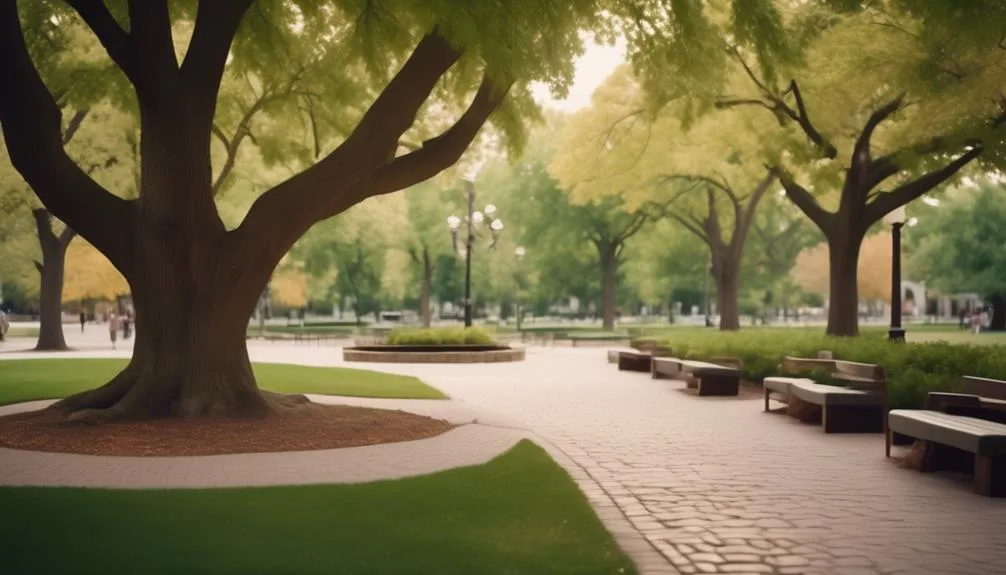Elm trees hold a special place in landscape architecture due to their graceful branches, vibrant leaves, and sturdy trunks. Their importance goes beyond just looks, impacting the environment and functionality of designed landscapes.
But what makes them so significant? Well, the answer may surprise you. These majestic trees play a crucial role in enhancing the overall aesthetics and sustainability of landscape design.
Let's explore why elm trees are more than just beautiful additions to the scenery.
Benefits of Elm Trees in Landscape Design
Elm trees offer a multitude of benefits in landscape design. They enhance the visual appeal while providing shade and habitat for wildlife. Symbolizing strength and resilience, these majestic trees bring a sense of endurance and stability to any landscape.
Their graceful, arching branches and vibrant green foliage create a picturesque and inviting atmosphere. Elm trees are highly valued for their exceptional disease resistance, making them a practical and low-maintenance choice for landscaping.
Their ability to withstand harsh environmental conditions and resist common diseases, such as Dutch elm disease, makes them a reliable and enduring addition to any outdoor space.
When considering landscape design, the symbolism and disease resistance of elm trees make them an ideal choice for adding both beauty and practicality to your surroundings.
Elm Trees as Urban Shade Providers
Shading the bustling streets and sidewalks, urban landscapes benefit from the cooling shelter provided by these resilient trees. Elm trees play a crucial role in urban cooling, significantly impacting the environment and public health. Here's why they're indispensable in city planning:
- Environmental Impact
- Elm trees absorb carbon dioxide and release oxygen, contributing to air purification and reducing the urban heat island effect.
- Their dense foliage provides effective shade, lowering ambient temperatures and decreasing energy consumption for air conditioning, thus mitigating greenhouse gas emissions.
- Public Health
- The shade offered by elm trees creates comfortable outdoor spaces, encouraging physical activity and social interactions, ultimately enhancing community well-being.
- By reducing exposure to harmful UV radiation, these trees help prevent skin cancer and other related health issues.
Elm trees aren't just majestic additions to urban landscapes; they're vital contributors to creating sustainable and livable cities.
Elm Trees as Ornamental Focal Points
With their graceful, arching branches and distinctive bark patterns, elm trees add an enchanting touch to any landscape, serving as captivating ornamental focal points.
Elm trees bring a sense of timeless beauty and elegance to outdoor spaces, making them perfect for creating visually stunning focal points in gardens, parks, and urban areas. Their aesthetically pleasing canopy and attractive foliage make them a popular choice for landscape architects aiming to create picturesque settings.
Elm trees also hold significant symbolism, representing strength, resilience, and wisdom in many cultures. Their majestic presence and rich history add depth and meaning to any landscape design.
Whether used as a solitary centerpiece or as part of a larger composition, elm trees infuse landscapes with a sense of tranquility and charm, making them invaluable in landscape architecture.
Elm Trees for Ecosystem Diversity
Enhancing the diversity of ecosystems, elm trees play a vital role in providing habitat and sustenance for a wide array of flora and fauna. They contribute significantly to ecosystem health and support wildlife habitat in various ways:
- Shelter: Elm trees provide nesting sites and shelter for birds, small mammals, and insects, contributing to the overall biodiversity of the landscape.
- *Example:* The dense canopy of mature elm trees offers protection and nesting opportunities for a variety of bird species such as robins, warblers, and chickadees.
- Food Source: Elm trees produce seeds, nectar, and foliage that serve as essential food sources for numerous insects, birds, and small mammals.
- *Example:* The seeds of elm trees are a crucial food source for squirrels and various bird species, enhancing the food web within the ecosystem.
Elm trees thus play a crucial role in sustaining the intricate web of life within diverse ecosystems.
Elm Trees in Sustainable Landscape Practices
Incorporating elm trees into sustainable landscape practices not only adds aesthetic value but also contributes to the overall health and resilience of the environment. Elm trees play a crucial role in tree preservation, as they are resistant to Dutch elm disease and can live for centuries, providing long-term environmental impact. Here's a glimpse of the environmental benefits:
| Environmental Benefits | Description | Emotional Response |
|---|---|---|
| Carbon Sequestration | Absorb and store CO2 | Reduced anxiety |
| Air Quality Improvement | Filter pollutants | Sense of relief |
| Biodiversity Support | Provide habitat for fauna | Feeling of harmony |
| Soil Erosion Prevention | Stabilize soil | Sense of security |
| Shade Provision | Cooling effect | Comfort and calm |
Conclusion
Incorporating elm trees into landscape design not only enhances aesthetics but also promotes sustainability and contributes to a healthy ecosystem.
Whether in a park, urban area, or residential landscape, elm trees play a vital role in creating a functional and visually appealing environment.
Their provision of shade and visual interest adds to the overall beauty and functionality of outdoor spaces, making them a valuable addition to any landscape design project.

My interest in trees started when I first saw the giant sequoias in Yosemite.
I was a teenager then, and I remember thinking, “I need to learn more about this.”
That moment stuck with me.
A few years later, I went on to study forestry at Michigan Tech.
Since graduating, I’ve worked in a mix of hands-on tree care and community education.
I’ve spent over ten years helping people understand how to plant, maintain, and protect the trees in their neighborhoods.
I don’t see trees as just part of the landscape.
They are living things that make a real difference in our daily lives.
